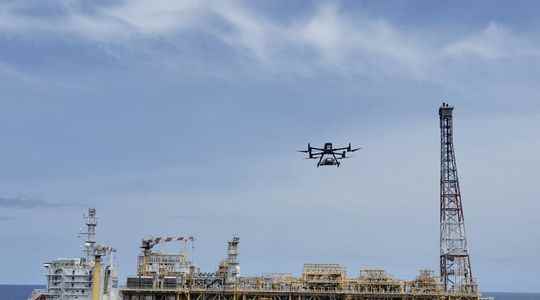Four small propellers, a wingspan of one meter at most, a weight not exceeding 10 kilos… For the operators of Likouf, a 250-metre-long floating oil platform belonging to TotalEnergies and moored off the Congo, the drone Ausea will be but a black spot in the azure horizon of the South Atlantic. For the company, this aircraft equipped with a carbon dioxide and methane sensor is nevertheless of strategic importance. This is in any case what the tricolor firm defends, it which launched last Monday a global campaign to detect its methane emissions thanks to drones.
Less known than CO2, CH4 is a formidable enemy of the climate. Its warming potential is 80 times greater than that of CO2 over a period of twenty years. The energy industry, for its part, accounts for a quarter of global emissions, including 60% for the oil and gas sector alone. A reality that companies in the sector intend to tackle. TotalEnergies, a good student, has already halved its methane emissions between 2010 and 2021, dropping from 120,000 to 49,000 tonnes per year. And the group is committed to stepping up the effort to reduce its emissions by 80% by 2030 compared to 2020.
It is still necessary to identify its origin. They are of three kinds in this industry. First of all, there are the emissions linked to the vents. These intentional releases of methane, due to operational or safety procedures, account for half of the total. Then come the so-called flaring emissions, by which the oil or gas companies burn part of the gas that they do not use. In this process, small amounts of unburned methane escape. Finally, fugitive emissions or leaks represent a quarter of the total.
How to reduce methane emissions?
Tested for two years, Ausea drones will provide an additional layer of precision for detection. “It’s complementary to the measurements we make with our infrared cameras, our sensors on the ground or by satellite”, explains Louise Tricoire, manager of the Customer Line CO2 unit at TotalEnergies. In Nigeria, a drone spotted a leak which, when fixed, reduced emissions by 4,000 tons. “The merit of drones is to be able to detect leaks offshore and in very humid regions such as West Africa, where satellites have less good visibility”, recognizes an industrialist in the sector. Which nevertheless warns: “The problem with the drone is that the operator of the installation knows when it is going to pass, which induces a bias in the operation of the site. The daily monitoring of all the installations by satellite remains most relevant.”
Moreover, it is not enough to detect emissions, it is still necessary to act to reduce them. TotalEnergies has been chasing gas flaring for several years and is trying to recover the gas to avoid vents. Operations that have a cost. The Ausea campaign alone amounts to 5.5 million euros. The fact remains that by acting in this way on its own operations, the French group is reducing its CO2 footprint without having to act on its level of oil production, to the great displeasure of environmental associations. Moreover, these investments are largely absorbable given the current surge in black gold prices.
